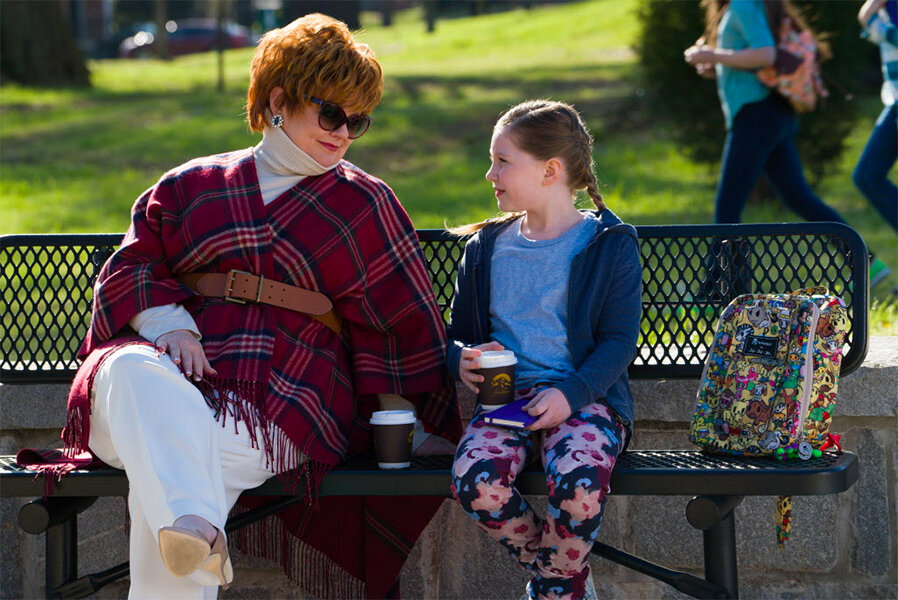Melissa McCarthy's 'The Boss': Another year of female leads in blockbusters?
Loading...
As Melissa McCarthy's comedy "The Boss," opens Friday, she is the latest exhibit in a Hollywood trend: Casting women as the lead protagonist in a major film.
Ms. McCarthy has had a string of leading roles in the traditionally male-dominated comedy genre, and 2015 was a high-water mark for leading ladies.
A recent study by the Center for the Study of Women in Television and Film at San Diego State University, showed that 22 percent of the main characters in the top 100 domestically highest-grossing films of 2015 were female – nearly double the percentage from the prior year. This is the highest the percentage of female protagonists in box office blockbusters has been since at least 2011, the study showed.
Paul Levinson, professor of communication and media studies at Fordham University and author of "The Plot to Save Socrates,” says there have always been women in leading roles – think Scarlett O’Hara (Vivien Leigh) in “Gone With the Wind.” The change he sees is in the kind of films now casting women as the stars.
“What has changed … is women who are lead roles in action, blockbuster movies,” Mr. Levinson says in a phone interview.
The shift was driven by Katniss Everdeen, played by Jennifer Lawrence, in the "Hunger Games."
“We tend to sometimes forget how rare it is for a series to be that successful,” he says of "Hunger Games." (The four-film franchise is one of the biggest box office successes of all time, ranking alongside such movie series as “Spider-Man” and Jurassic Park.”) “…When a series is successful, other people in the industry want to gain some of that success for their own work and I'm sure that in the next … years, we're going to see other series in which you have a central character as powerful as Katniss.”
But Hollywood has taken note. That's most likely one reason "Star Wars: The Force Awakens" featured protagonist Rey (Daisy Ridley), who was in what is now the highest-grossing film of all time domestically without adjusting for inflation. Carrie Fisher’s Princess Leia was heavily involved in the story in the original “Star Wars” movies, but Levinson points out that the original film trilogy was very much the story of budding Jedi Luke Skywalker (Mark Hamill).
“The new movie has a woman in a very, very central role,” Levinson says. “[Rey] is in the role that Luke Skywalker used to have. Men play very important roles, but slightly secondary.”
And of course, these female roles wouldn't get onscreen if those behind the scenes in Hollywood didn't make it happen.
The movie “Brooklyn,” which stars Oscar nominee Saoirse Ronan, was released last year, and appears in the list of 100 highest-grossing films domestically, was written by Nick Hornby. Mr. Hornby, also an author, has received attention recently for his work adapting stories for the screen that feature female protagonists, with past work including the 2009 movie “An Education” and the 2014 movie “Wild.”
“I only want to write books and movies about women,” Hornby told the Los Angeles Times.
Actress Reese Witherspoon has also been spotlighted for bringing stories with female protagonists to the big screen via her production company, Pacific Standard, which she created with Bruna Papandrea. The company was behind the 2015 film “Hot Pursuit,” which starred Ms. Witherspoon and Sofia Vergara and also made the list of 100 highest-grossing films for the year. Pacific Standard also produced the 2014 movies “Gone Girl” and “Wild.”
Witherspoon told Variety she asked studios, “What are you developing for women?”
“I think it was literally one studio that had a project for a female lead over [the age of] 30,” she said. “And I thought to myself, ‘I’ve got to get busy.’”
While it remains to be seen whether 2016 will be an improvement or a step back, films with female protagonists released so far this year have included the dystopian movies “The 5th Wave,” which stars Chloe Grace Moretz, and “The Divergent Series: Allegiant,” starring Shailene Woodley, as well as the comedy “How to Be Single,” which centered on characters played by Dakota Johnson, Rebel Wilson, Alison Brie, and Leslie Mann.
And McCarthy, Kristen Wiig, Kate McKinnon, and Leslie Jones will star this summer with an all-female-leads remake of "Ghostbusters."
But even with the encouraging data from 2015, the progress so far has been primarily for white women – not minorities. The study released by San Diego State University noted 76 percent of all female characters were white.
In addition, it's still rare for female directors to bring these stories to the screen. There are so few women working as directors in both film and TV that in late 2015, the federal Equal Employment Opportunity Commission began interviewing female directors to see if there was basis for a class-action lawsuit.
"There's been very, very little progress made," Levinson says of any increase in female directors. "...I think you could make the point that until we have more women directors, we're not going to see women fully portrayed and totally accurately portrayed in movies."






